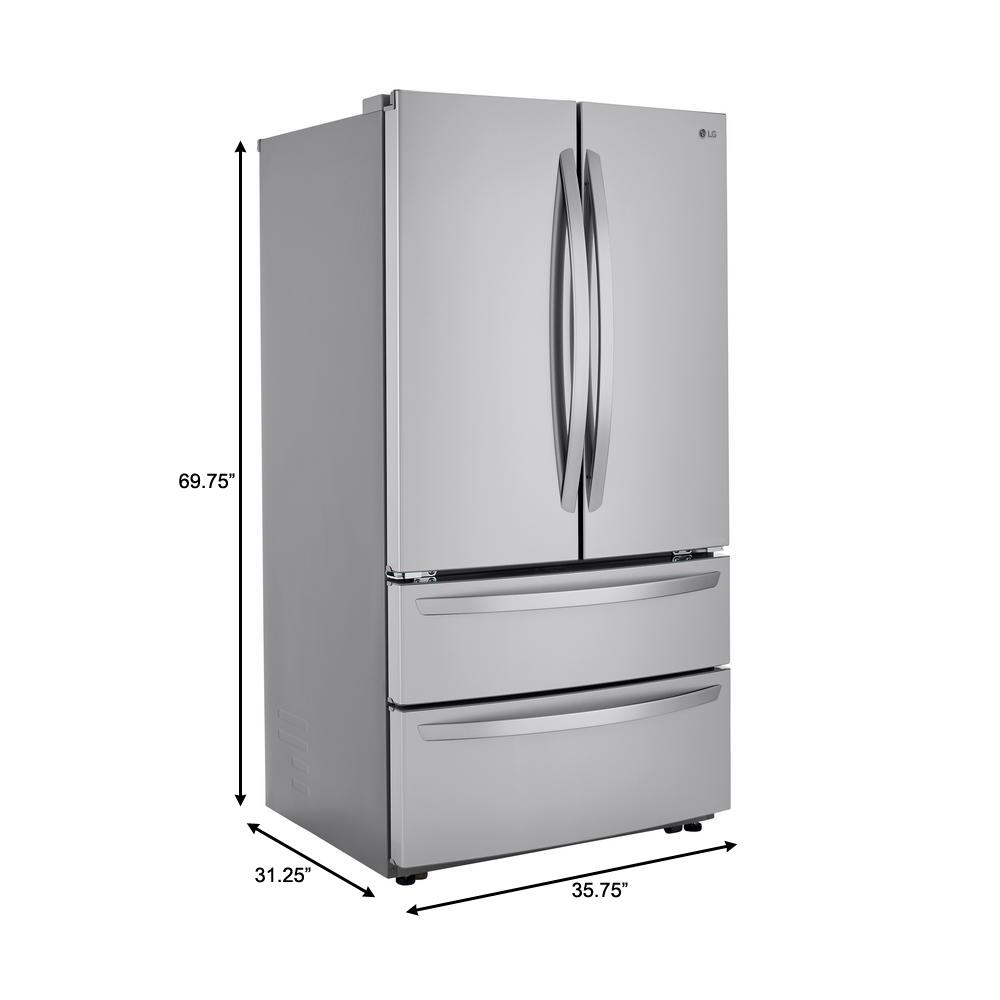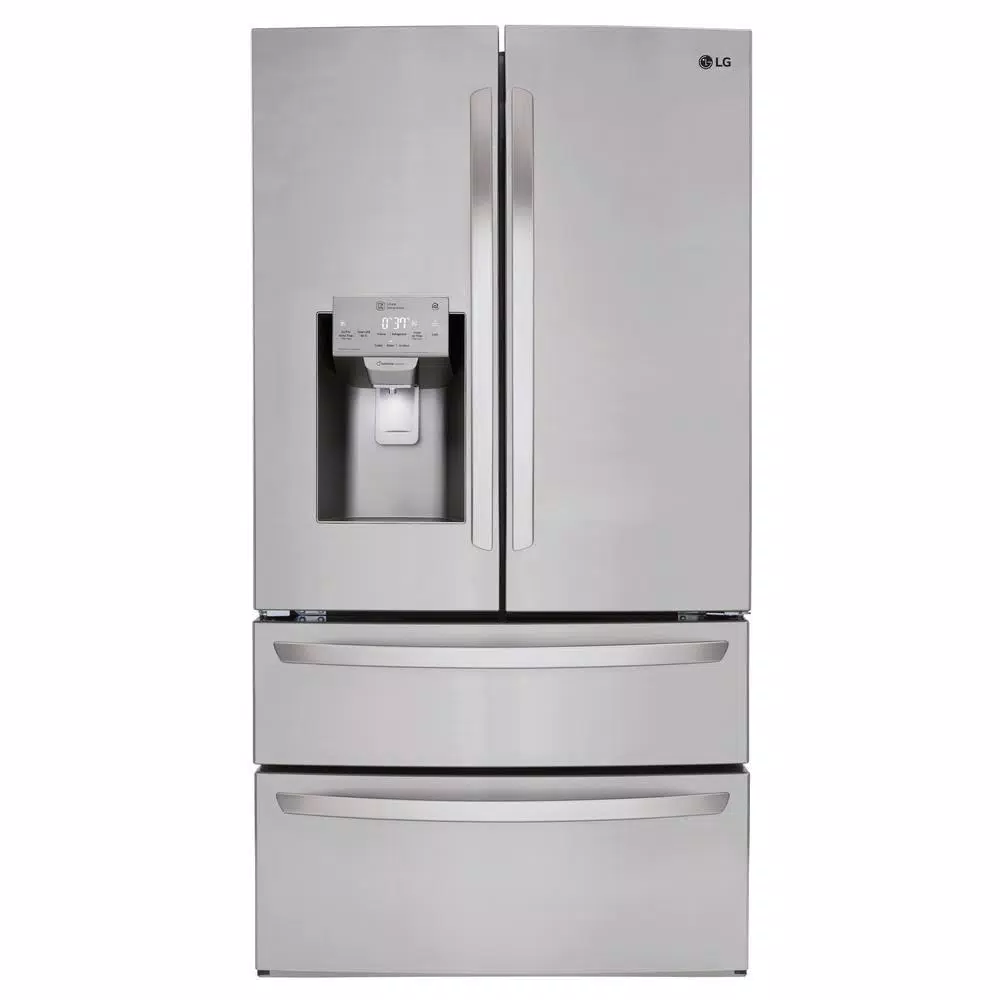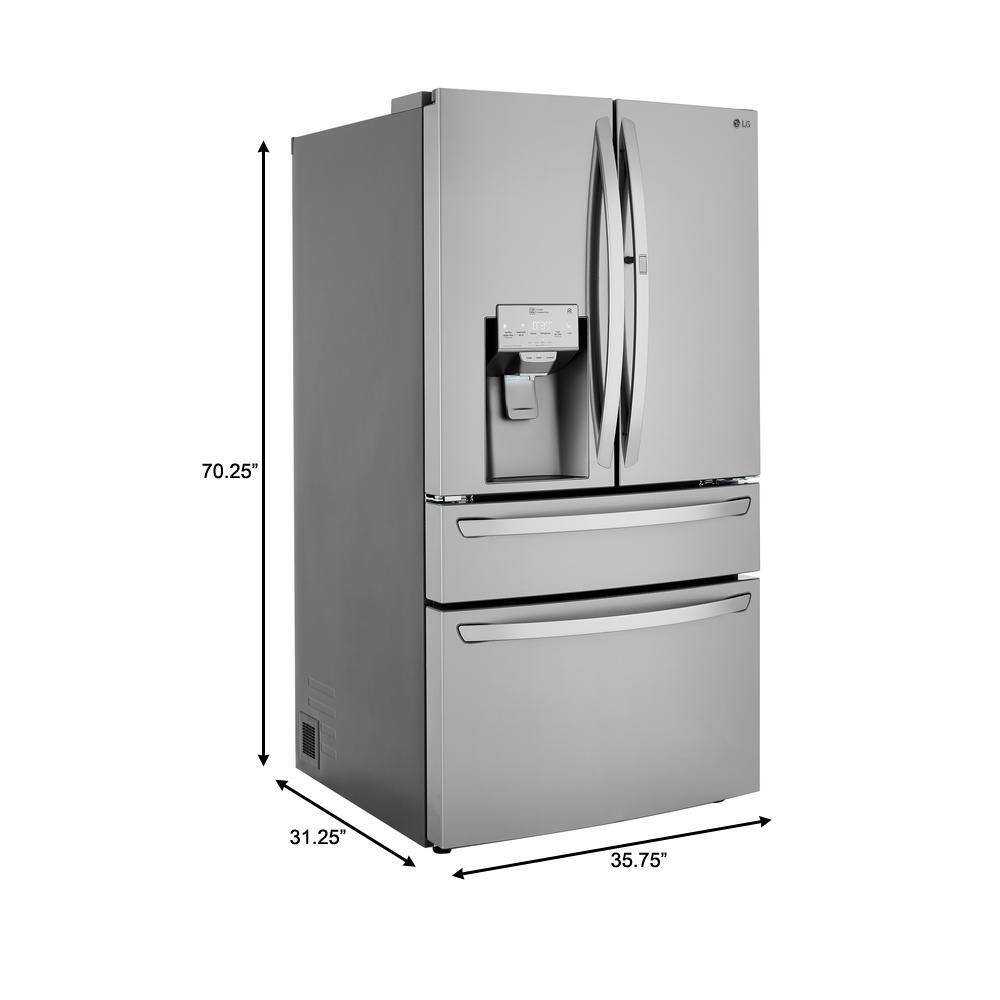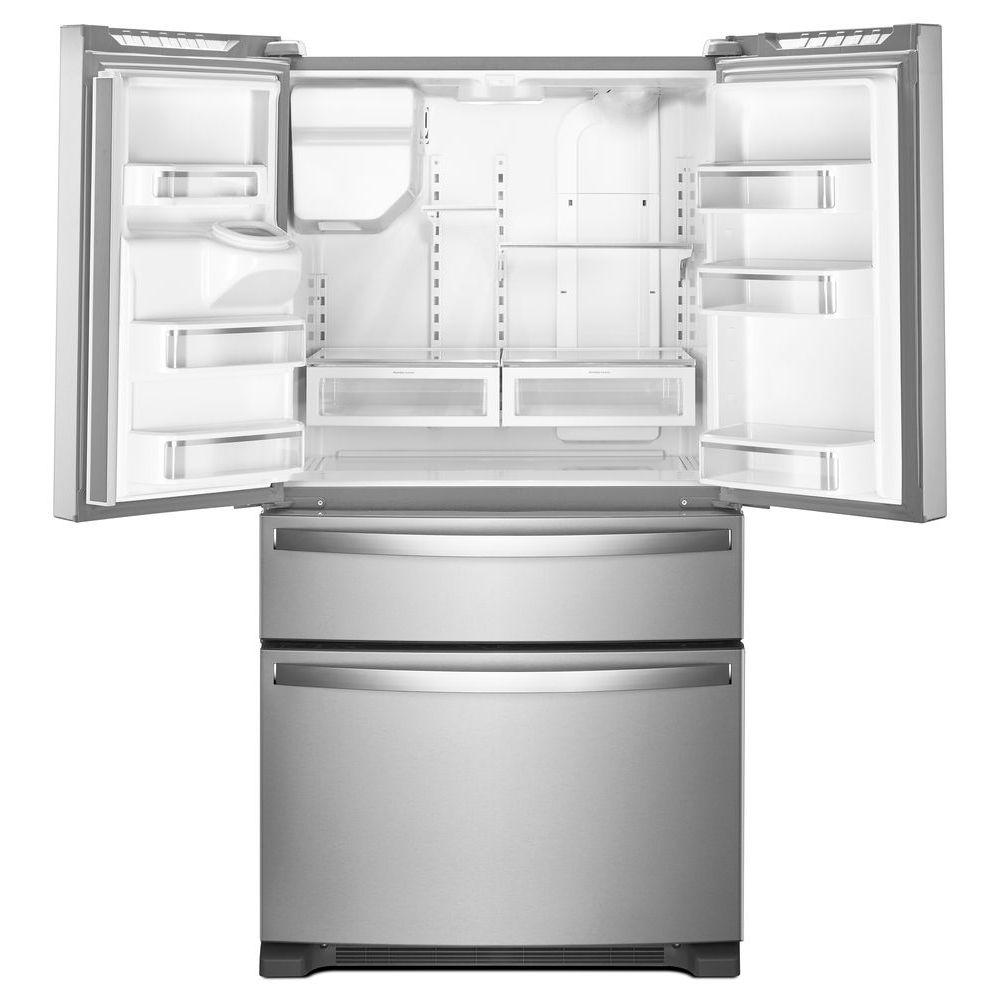LG Electronics 23 cu. ft. 4-Door French Door Refrigerator with 2 Freezer Drawers in PrintProof Stainless Steel, Counter Depth
Counter-depth refrigerator creates a seamless, built-in look. Access fresh filtered water with NSF certified water dispenser. Features two crisper drawers and fingerprint resistant finish.
If you’ve ever wished you had more space to get more organized, your wish has been granted. With 23 cu. Ft., you get that extra space in a counter depth design. Thanks to the ultimate organization of the double freezer drawers, you can forget frozen-food avalanches-you’ve got a place for everything from popsicle to a family-size turkey. You also get extras like internal water dispenser for a clean exterior design and Door Cooling+ technology, designed to help keep all that extra food fresher, longer.
-
Get more space for groceries in a great feature-packed refrigerator; Nothing beats the convenience of having more food when you need it, and with a generous 23 cu. ft. of space, you’ll have room and room to grow
- Enjoy a built-in look with the counter depth feature on this LG refrigerator; Thanks to its slightly shallower depth, it can stand flush with your counter top for a sleek look
- Leave the pint of ice cream and frozen turkey where they belong; With 2 separate freezer drawers, you have easy, organized access to the things you need often—and ample, lower space for the things you don’t
- Now you can have all of the things you love about stainless, without the need for special cleaners or constant attention. LG’s PrintProof fingerprint and smudge resistant finish easily wipes clean with a soft, dry cloth for a distinctive kitchen that handles real-life in style
- Easily access fresh filtered water with an internal water dispenser; You can conveniently fill your cup, pitcher or even a small sauce pot with clean cold water
- The 2 crisper drawers gives you easy access to your fruits, vegetables and beverages; This refrigerator also features a full-width Glide N’ Serve pantry drawer, making the it easy to find some space for all that food you want to keep fresh
- LG’s new pharmaceutical water filter, NSF certified to reduce more contaminants than our previous filters, for freshness you can taste
- Located in the top of the fresh food section, the Door Cooling + vent extends the reach of LG’s Smart Cooling system; Blasts of cool air reach all areas of the refrigerator—including the door—to help maintain consistent temperatures from top to bottom. It helps keep all foods fresh and flavorful and keeps produce fresh up to 2X longer
- Smart Cooling system is designed to maintain superior conditions within the refrigerator; The Linear Compressor reacts quickly to temperature fluctuations and helps keep your food fresher, longer; Meanwhile, strategically-placed vents in every section help to surround your food with cool air no matter where you put it
- SmartDiagnosis helps the service center diagnose problems over the phone, helping you troubleshoot quickly
- When you buy a refrigerator, you don’t want to worry that it won’t last; Because the Linear Compressor motor uses fewer moving parts and operates more efficiently, LG confidently backs the motor with a 10-year limited warranty
- This ENERGY STAR qualified LG refrigerator exceeds federal energy standards to positively impact your energy bill, your energy consumption, and most importantly, the environment
Additional information
| Depth (Excluding Handles) | 28.63 |
|---|---|
| Depth (Including Handles) | 31.25 |
| Depth (Less Door) | 24.75 |
| Depth With Door Open 90 Degrees (In) | 43.28 |
| Height to Top of Door Hinge (in.) | 69.75 |
| Height to Top of Refrigerator (in.) | 68.38 |
| Product Depth x Height x Width (in.) | 31.25 x 69.75 x 35.75 |
| Refrigerator Width (In.) | 35.75 |
| Certifications and Listings | No Certifications or Listings |
| Manufacturer Warranty | Limited Warranty: 1 Year Parts & Labor, 5 Years Sealed System & Compressor (Parts & Labor), 6-10 Years Linear Compressor (Parts Only) |






by Teden
If one can be in love with a major appliance, I’m in love with this refrigerator! It fits in the same fairly confined space as our old one, but seems so much bigger it’s crazy!. I love the clean look on the outside; no messy ice/water dispenser, but water dispenser inside the unit is awesome and the ice in the first freezer drawer is convenient. There is so much room in the refrigeration part, spacious shelves, 2 fruit/veggie drawers, and plenty of space for storage inside both doors. We love the deli drawer; it’s the entire length of the refrigerator and you can see nicely in it without having to open it; lots of storage for sandwich fixings, cheese, etc. The bottom drawer of the freezer is separated in two sections with a moveable plastic divider, which adds to the flexibility of storage in this drawer and it’s quite deep too. The one this I do wish is that you could adjust the storage shelves in the doors, but it’s not a big deal as it ended up working nice for our needs anyway.
by Valenfa
I bought this model early this year and so far I had nothing but great experiences. I also like how Lg products connects to the Lg App and change settings on your fridge like ice plus.
by Winner
Better than I thought it would be! I had to get a fridge I really didn’t want due to the delay in product due to Covid. Very happy with my choice.
by Bill
I commend LG on the design of this refrigerator. The bottom drawer freezer 2.0 is great, open up the top for ice & keep the things there that you use frequently. Keep the larger items that are used infrequently in the bottom. The touchless water dispenser is very handy. The inside of the refrigerator is huge, shelves are sturdy & the blue LED lighting is cool. The outside of this thing is beautiful! It is so quiet that I didn’t think that it was working when I plugged it in. The only fault I can find that others commented on as well, the icemaker is slow, about 3 hours or so per batch. There is a workaround for the icemaker though, if you push the ice away from the back left corner of the bin where ice level is sensed it will continue to make ice & keep the bin fuller.
by Momma
I have had this fridge for three weeks. I love how spacious it is and love the water dispenser inside instead of on the door. The ice machine is working great. The double drawers on the freezer make separating frequently used foods much easier.
by Mike
So far, so good! Delivered June 11, 2020. Ice making is slow but otherwise food stays cold even in the doors! We are pleased so far!
by Helen
We have had the refrigerator for one week, and so far we are satisfied with the purchase. The front of the refrigerator is very sleek and is not spoiled by displays, buttons, windows, or ice/water dispenser. The handles and drawers can be easily removed before sliding through a narrow doorway. I found a helpful YouTube for removing and replacing the freezer drawers. The top freezer drawer has a light, but the bottom drawer does not. Both freezer drawers slide out completely to easily reach items. It runs very quiet only making noise when dumping ice and refilling the trays. Shortly after installing, I used the LG ThinQ app to confirm the refrigerator was working as it should.
by Lorewisp
This is a very good refrigerator. It was not our top pick, but considering that it is rated high with CR and others, made it our final choice. We like the French doors, just wish this refrigerator had them on the freezer as well. The high end LG does, but at $6000+ was not worth it to us. The fact that it is counter depth was one our requirements, although the doors exceed the counter, but not like a regular sized frig. It has the water dispenser in the upper portion of the frig in the side wall, which we like. The ice machine is in the top freezer drawer. It seems to be limited in the amount of ice it can produce, even with the ICE PLUS feature, but it is plenty for us. The bottom freezer door does not have a light, so that makes it more difficult to see things if it is dark or with dim kitchen lighting. The upper drawer where the ice bin is located has a light and that works well. I must say that the refrigerator top is very well lit and the fact that this comes with a easy to reach water filter is a plus. Also, it has a air filter which we didn’t realize that came with the frig. They do send a water filter with the frigs on installation, but you will need to order the air filter to install once you get the frig delivered. The phone app to determine problems with the frig worked well. Just wish they would have put stainless steel on the sides. One side or our refrigerator is exposed. Although it is a nice finish in medium grey, it takes away from the total stainless steel look from the front. Overall, it is a good purchase that should last us years.